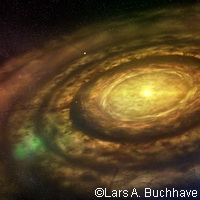Not so predictable: small planets can form around stars with less heavy elements
Scientists long believed that small Earth-like planets only formed around stars with a high content of elements such as iron and silicon, but now a new study from researchers in Denmark, Sweden and the United States shows that small planets can actually form around stars with a wide range of heavy element content. These findings increase the likelihood that small Earth-like planets could be much more widespread in the Universe than was previously thought. For the study, published in the journal Nature, the team used the National Aeronautics and Space Administration's (NASA's) Kepler Space Telescope to examine the elemental composition of more than 150 stars harbouring 226 planet candidates smaller than Neptune. One of the researchers, Anders Johansen from Lund University, Sweden, was supported by a European Research Council (ERC) Starting Grant for the PEBBLE2PLANET ('From pebbles to planets: towards new horizons in the formation of planets') project. It is funded to the tune of EUR 1 330 000 under the 'Ideas' Theme of the EU's Seventh Framework Programme (FP7). Lead study author Lars A. Buchhave, an astrophysicist based at the Niels Bohr Institute and the Centre for Star and Planet Formation at the University of Copenhagen, comments: 'I wanted to investigate whether small planets needed a special environment in order to form, like the giant gas planets, which we know preferentially develop in environments with a high content of heavy elements. This study shows that small planets do not discriminate and form around stars with a wide range of heavy metal content, including stars with only 25 percent of the sun's metallicity.' The study reveals that planets up to four times the size of Earth can form around stars with a wide range of heavy element content, including stars with a lower metallicity than the sun. A star is a large ball of glowing gas that produces energy by fusing hydrogen and helium into heavier and heavier elements. When the entire core has been converted into iron, no more energy can be extracted and the star dies, launching massive clouds of dust and gas out into space. These large clouds of gas and dust then condense and turn into new stars and planets. Each generation of star has a higher heavy element content than the preceding one. Planets are formed from the remains of the clouds of gas and dust that rotate around the newly formed star. In later generations of stars with a high content of heavy elements, the remaining dust and gas particles that go on to form planets have an elemental composition that is most likely to promote the formation of gas giants like Saturn and Jupiter. But this new study shows that things are different for smaller planets, as Lars A. Buchhave explains: 'We have analysed the spectroscopic elemental composition of the stars for 226 exoplanets. Most of the planets are small, i.e. planets corresponding to the solid planets in our solar system or up to four times the Earth's radius. What we have discovered is that, unlike the gas giants, the occurrence of smaller planets is not strongly dependent on stars with a high content of heavy elements. Planets that are up to four times the size of Earth can form around very different stars - also stars that are poorer in heavy elements.' Therefore, as they are not dependent on a high content of heavy elements in host stars in order to be formed, Earth-like planets could be much more widespread throughout the galaxy than we think. Since its launch in 2009, the Kepler Space Telescope has been searching for planets by continuously monitoring more than 150 000 stars, looking for telltale dips in their brightness caused by passing, or transiting, planets. At least three transits are required to verify a signal as a planet. Follow-up observations from ground-based telescopes are also needed to confirm a candidate as a planet. The ground-based spectroscopic observations for this study were made at the Nordic Optical Telescope (NOT) on La Palma in the Canary Islands, and three telescopes across the United States: the Fred Lawrence Whipple Observatory (FLWO) on Mount Hopkins in Arizona; the McDonald Observatory at the University of Texas in Austin; and W. M. Keck Observatory on Mauna Kea in Hawaii.For more information, please visit:University of Copenhagen:http://www.ku.dk/english/
Countries
Denmark, Sweden, United States



